
A poppy is a flowering plant in the subfamily Papaveroideae of the family Papaveraceae. Poppies are herbaceous plants, often grown for their colourful flowers. One species of poppy, Papaver somniferum, is the source of the narcotic drug opium which contains powerful medicinal alkaloids such as morphine and has been used since ancient times as an analgesic and narcotic medicinal and recreational drug. It also produces edible seeds. Following the trench warfare in the poppy fields of Flanders, Belgium during World War I, poppies have become a symbol of remembrance of soldiers who have died during wartime, especially in the UK, Canada, Australia, New Zealand and other Commonwealth realms.
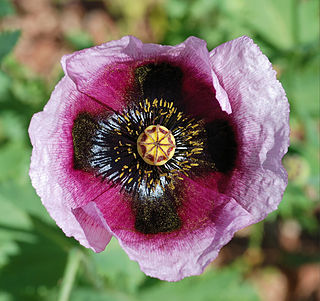
Papaver is a genus of 70–100 species of frost-tolerant annuals, biennials, and perennials native to temperate and cold regions of Eurasia, Africa and North America. It is the type genus of the poppy family, Papaveraceae.

Papaver somniferum, commonly known as the opium poppy or breadseed poppy, is a species of flowering plant in the family Papaveraceae. It is the species of plant from which both opium and poppy seeds are derived and is also a valuable ornamental plant, grown in gardens. Its native range is probably the eastern Mediterranean, but is now obscured by ancient introductions and cultivation, being naturalized across much of Europe and Asia.
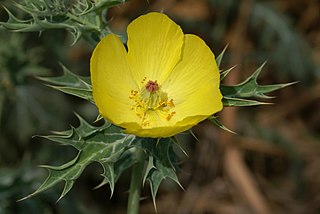
Argemone mexicana is a species of poppy found in Mexico and now widely naturalized in many parts of the world. An extremely hardy pioneer plant, it is tolerant of drought and poor soil, often being the only cover on new road cuttings or verges. It has bright yellow latex. It is poisonous to grazing animals, and it is rarely eaten, but it has been used medicinally by many peoples, including those in its native area, as well as the Natives of the western US, parts of Mexico and many parts of India. In India, during the colorful festival Holika Dahan, adults and children worship by offering flowers, and this species is in its maximum flowering phase during March when the Holi festival is celebrated. It is also referred to as "kateli ka phool” in India.

Epidemic dropsy is a form of edema of extremities due to poisoning by Argemone mexicana.
The name Catuaba is used for the infusions of the bark of a number of trees native to Brazil. The most widely used barks are derived from the trees Trichilia catigua and Erythroxylum vaccinifolium. Other catuaba preparations use the bark of trees from the following genera or families: Anemopaegma, Ilex, Micropholis, Phyllanthus, Secondatia, Tetragastris and species from the Myrtaceae.

Sanguinarine is a polycyclic quaternary alkaloid. It is extracted from some plants, including the bloodroot plant, from whose taxonomic name, Sanguinaria canadensis, its name is drawn; the Mexican prickly poppy ; Chelidonium majus; and Macleaya cordata.
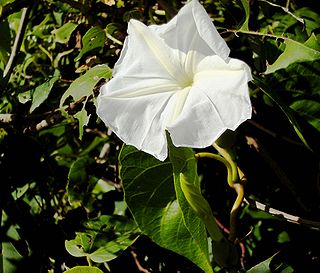
Ipomoea violacea is a perennial species of Ipomoea that occurs throughout the world with the exception of the European continent. It is most commonly called beach moonflower or sea moonflower as the flowers open at night.

Berberine is a quaternary ammonium salt from the protoberberine group of benzylisoquinoline alkaloids found in such plants as Berberis vulgaris (barberry), Berberis aristata, Mahonia aquifolium, Hydrastis canadensis (goldenseal), Xanthorhiza simplicissima (yellowroot), Phellodendron amurense, Coptis chinensis, Tinospora cordifolia, Argemone mexicana, and Eschscholzia californica. Berberine is usually found in the roots, rhizomes, stems, and bark.
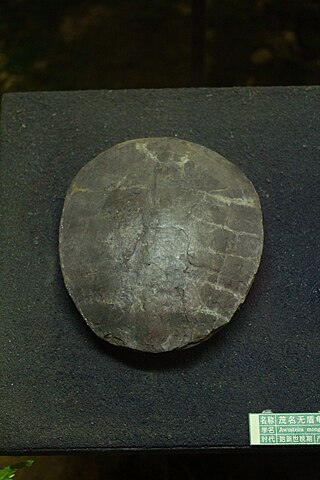
Anosteira is an extinct genus of carettochelyid turtle from the Eocene to the Oligocene of Asia and North America.
Peronospora arborescens is a plant pathogen. It causes downy mildew on leaves of Papaver spp. It has economic importance on Papaver somniferum grown as an oilseed crop, for example in central and eastern Europe. It is controlled by sanitation, crop rotation, use of clean seed and fungicide sprays of the foliage. There are other species of Peronospora which occur on Papaver: Peronospora argemones (Gäum.), Peronospora cristata (Tranzschel), and Peronospora papaveris-pilosi (Vienn.-Bourg.).

Myricetin 3-O-rutinoside is a chemical compound. It can be isolated in Chrysobalanus icaco and in fruits.

Dictyotaceae is large family of brown algae. Members of this family generally prefer warmer waters than other brown algae. Lobophora variegata often presents a beautiful blue iridescence due to microscopic bacteria which live on the surface of the blades. A number of genera are known as forkweed (e.g. Dictyota, Glosophora, Dilophus, Dictyopteris, Pachydictyon and Lobospira.
The Sociedade Brasileira de Geofísica (SBGf) is Brazil's national scientific and technical society for geophysicists. It was founded in 1978 and held its first conference in 1989 and every other year since then. Its aim is the development of geophysics in Brazil and is closely involved with the Brazilian oil and gas industry.
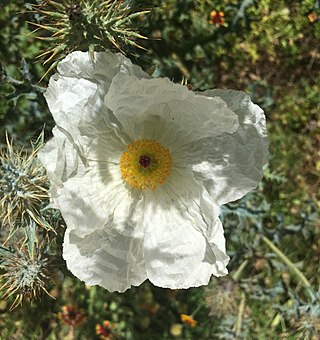
Argemone albiflora, the white prickly poppy, also known as the bluestem prickly poppy or the Texas prickly poppy, is a small erect plant with a decorative white flower with a yellow latex. It is deeply rooted with yellow or red stamens. The plant is known for the sharp prickles on its stem and leaves. The sepals fall off as the flower of this plant grows bigger. It grows in the arid regions of the southern Midwest along roadsides and disturbed pieces of land. Native Americans have long revered this plant for its medicinal and other uses.

Allocryptopine is a bioactive alkaloid found in plants of the Papaveraceae family, including Glaucium arabicumArgemone mexicana, Eschscholtzia, Corydalis, Fumaria, Chelidonium, Hunnemannia fumariifoliaEschscholzia lobbii and more other Papaveraceae plants.

Annona jahnii is a species of plant in the family Annonaceae. It is native to the Brazil, Colombia and Venezuela. William Edwin Safford, the American botanist who first formally described the species, named it after the Venezuelan scientist, explorer and mountain climber Alfredo Jahn.

Fusaea longifolia is a species of plant in the family Annonaceae. It is native to Brazil, Colombia, Ecuador, French Guiana, Guyana, Peru, Suriname and Venezuela. Jean Baptiste Christophore Fusée Aublet, the French botanist who first formally described the species using the basionym Annona longifolia, named it after its long-leaved foliage.
















